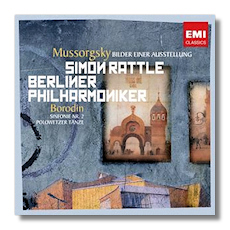
The Internet's Premier Classical Music Source
Related Links
-
Borodin Reviews
Mussorgsky Reviews - Latest Reviews
- More Reviews
-
By Composer
-
Collections
DVD & Blu-ray
Books
Concert Reviews
Articles/Interviews
Software
Audio
Search Amazon
Recommended Links
Site News
 CD Review
CD Review
A New Year's Eve Concert in Berlin

Bilder Einer Ausstellung
- Modest Mussorgsky: Pictures at an Exhibition (orch. Maurice Ravel)
- Alexander Borodin:
- Symphony #2
- Prince Igor: Polovtsian Dances
Berlin Philharmonic Orchestra/Sir Simon Rattle
EMI Classics 500273-2 DDD 74:33
I know of at least one person who is out to collect every version of Pictures at an Exhibition ever recorded; here's another one for his collection. This time around, the occasion was New Year's Eve in Berlin. These performances were recorded live in concert on the last three days of 2007. (Trivia: in Germany, as well as in other European countries, New Year's Eve is called "Silvester," so what we have here is a traditional "Silvester Konzert." Apparently Pope Sylvester I died on that date in the year 335 – hence, the name.)
The New Year's concert is a strange tradition. The Vienna Philharmonic gives us music by the Strauss family, of course, but that's not a tradition that needs to be followed slavishly everywhere, as there's lots of popular and "light" music out there. Nevertheless, many orchestras apparently feel that we need to hear Strauss on New Year's Eve. Although I like Strauss's music just fine, I beg to differ. Why don't American orchestras do more Broadway evenings on this night? Also, Gilbert and Sullivan is very nice, and so is Offenbach. I'm not sure what the Berlin Philharmonic's tradition is, but the Russian program chosen for the end of 2007 probably pleased a lot of people. After all, who doesn't love Pictures at an Exhibition?
When you're playing this work with the Berlin Philharmonic, you have to answer to the ghost of Herbert von Karajan, whose Deutsche Grammophon recording of this work is definitive and belongs in any collection. What sounds he got out of the Philharmonic! What control over timbre! Every effect is calculated down to the last micron, and yet the performance as a totality never feels calculated or lacking in spontaneity. It's a triumph of science at the service of art, if you will.
Some of the Philharmonic's characteristic sound remains in place, even though it has been about twenty years since he last conducted them. (How many of "his" musicians remain?) Rattle's new recording of Pictures, however, is a relatively mild-mannered affair, as if he was trying to avoid criticism that this is vulgar music. However, once you accept that this is going to be a subtle interpretation, there is much to enjoy here, most of it related to the fantastic playing of the Philharmonic. Try, for example, "Tuileries" which is so crisp and well-timed it makes you laugh, or the mournful and wonderfully atmospheric reprise of the "Promenade" theme in "Cum mortuis in lingua morta." This is orchestral playing of the first rank. (On the other hand, some of the chords near the end of "The Great Gate of Kiev" are a little soggy.)
The "Polovtsian Dances" are similarly subtle, and one appreciates the colors that Rattle gets out of the brass – just foreign enough to remind us that the titular Prince Igor is a stranger in a strange land. I'm most excited, however, about the presence of Borodin's Second Symphony. This is not a rare score, exactly, but I don't think it gets played enough, and it is nice to hear Rattle and the Berlin Philharmonic give it the credit that it deserves. Again, this isn't a barn-storming reading, yet Rattle really doesn't do anything wrong, and the Philharmonic tones down the garishness heard in several other recordings of this work.
The booklet is entirely in German, almost as if it were a last-minute decision to make this disc available outside of Germany. Also, there's not a single timing to be found. Ah well, just revel in the sound of the Philharmonic, and don't ask too many questions!
Copyright © 2008, Raymond Tuttle




















